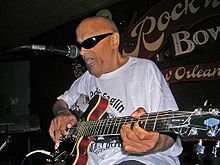- New Orleans blues
-
New Orleans blues Stylistic origins Blues - calypso music - Dixieland - rhythm and blues Cultural origins 1940 and 50s New Orleans, Louisiana, US Typical instruments Keyboards - saxophone - Guitar - bass guitar - drums Mainstream popularity 1950s and 1960s New Orleans blues, is a is a sub-genre of blues music and a variation of Louisiana blues that developed in the 1940s and 1950s in and around the city of New Orleans. Strongly influenced by jazz and incorporated Caribbean influences, it is dominated by piano and saxophone but has also produced major guitar bluesmen. Major figures in the genre include Professor Longhair and Guitar Slim, who both produced major regional, R&B chart and even mainstream hits.
Characteristics
As a style New Orleans blues is primarily driven by piano and horn, enlivened by Caribbean rhythms and Dixieland music. It is generally cheerful in delivery regardless of the subject matter, with a laid back tempo and complex rhythms falling just behind the beat. Vocals range from laid-back crooning to full-throated gospel shouting.[1]
History
 Snooks Eaglin performing in 2006
Snooks Eaglin performing in 2006
New Orleans is generally credited as the birthplace of jazz music, but has attracted less attention as a centre of the blues. Although it has drawn to it and produced fewer blues musicians than other major US urban centres with large African-American populations, it has been the center of a distinctive form of blues music, which has been pursued by some notable musicians and produced important recordings.[2]
In the period after World War II a very large number of recordings were produced in the city that were informed by the blues, but had strong R&B and pop influences that anticipated rock and roll and are difficult to classify.[2] Among these artists among the most highly regarded and most influenced by the blues was piano-player Professor Longhair, whose signature song "Mardi Gras in New Orleans" (1949) and other recordings like "Tipitina" (1959) were major R&B hits and who remained a central figure in New Orleans music through to his death in 1980.[3] Other significant figures playing keyboard-based blues include James Booker, whose organ instrumental "Gonzo" reached the top fifty in the Billboard chart in 1960 and was followed by a series of minor single hits.[4]
The most significant blues guitarist to emerge from the city in the post-World War II period was Guitar Slim. Originally from the Delta, his "The Things That I Used to Do", which combined gospel, blues and R&B, was a major R&B hit in 1954 and may have influenced the development of later soul music.[2] Other important blues guitarists from the city include Snooks Eaglin, who recorded both acoustic folk and electric-based R&B,[2] and Earl King, who composed blues standards including "Come On" (covered by Jimi Hendrix) and Professor Longhair's "Big Chief".[5] Also among the major figures of the genre was Dr John, who began as a guitarist and enjoyed regional success with the Bo Diddley influenced "Storm Warning" in 1959 and a highly successful career from the 1960s after moving to Los Angeles, mixing R&B with psychedelic rock and using New Orleans themed aesthetics.[6]
The careers of many New Orleans bluesmen declined in the 1960s as rock and roll and soul began to dominate popular music, but revived in the 1970s as there was renewed interest in their recordings.[2] In 2011 actor Hugh Laurie's album of New Orleans music Let Them Talk helped renew interest in the genre once again.[7]
Notes
- ^ Cub Coda, "New Orleans blues", Allmusic, archived from the original on 4 June 2011, http://www.webcitation.org/5zC4e24Fw.
- ^ a b c d e R. Unterberger, "Louisiana blues", in V. Bogdanov, C. Woodstra, S. T. Erlewine, eds, All Music Guide to the Blues: The Definitive Guide to the Blues (Milwaukee, WI: Backbeat Books, 3rd edn., 2003), ISBN 0-87930-736-6, pp. 687-8.
- ^ J. Tolf, ed., The Definitive Illustrated Encyclopedia Jazz and Blues (London: Flame Tree, 2007), ISBN 1844519988, p. 417.
- ^ B. B. Raeburn, "James Booker", in V. Bogdanov, C. Woodstra, S. T. Erlewine, eds, All Music Guide to the Blues: The Definitive Guide to the Blues (Milwaukee, WI: Backbeat Books, 3rd edn., 2003), ISBN 0-87930-736-6, p. 62.
- ^ T. Downs and J. T. Edge, New Orleans (London: Lonely Planet, 3rd edn., 2003), ISBN 1740591933, p. 28.
- ^ R. Unterberger, "Dr. John", in V. Bogdanov, C. Woodstra, S. T. Erlewine, eds, All Music Guide to the Blues: The Definitive Guide to the Blues (Milwaukee, WI: Backbeat Books, 3rd edn., 2003), ISBN 0-87930-736-6, p. 157.
- ^ C. L. Smith (23 March 2011), "Hugh Laurie plays first ever blues gig", Guardian.co.uk, archived from the original on 4 June 2011, http://www.webcitation.org/5zCIpjTwY.
Blues Subgenres Fusion genres Regional scenes British blues · Canadian blues · Chicago blues · Detroit blues · East Coast blues · Gospel blues · Hokum · Kansas City blues · Louisiana blues · Memphis blues · New Orleans blues · New York blues · Piedmont blues · St. Louis blues · Swamp blues · Texas blues · West Coast blues · Hill country bluesInstruments Other topics Lists Categories:- Blues music genres
- African American music
Wikimedia Foundation. 2010.
